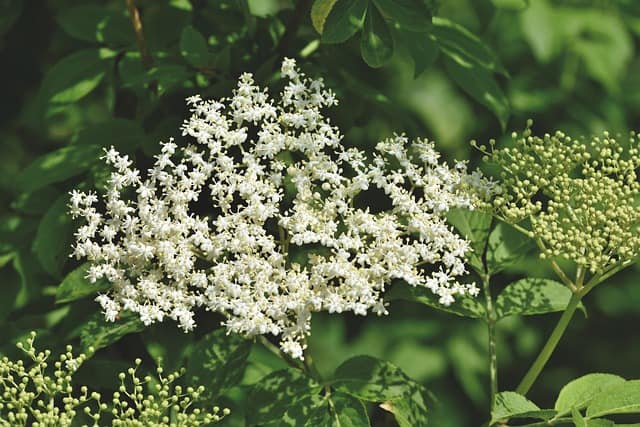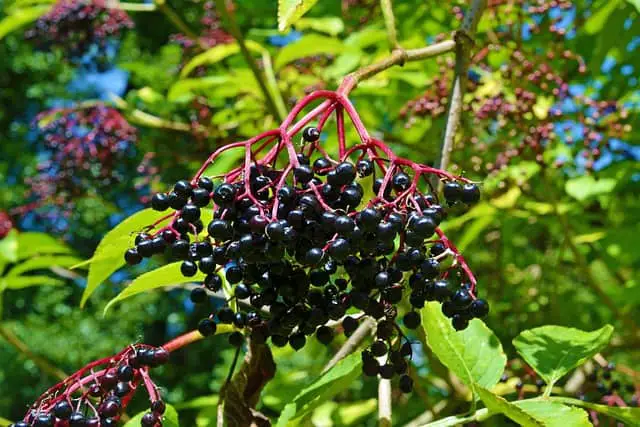Foragers in Utah are gifted with a wide variety of delicious edible plants. There is no shortage of vegetables and wild mushrooms to be found throughout the year. In the late summer, outdoor enthusiasts seeking out some vitamin C will find themselves staring down a variety of wild berries. It’s a time for eating fresh fruit salads and making delicious jams to last through the winter.
However, it’s important to keep in mind that many of the natural foods found in Utah are actually poisonous berries. The wise outdoor enthusiast will want to become well aware of the white snowberry and red baneberry, two wild fruits that are toxic to humans.
Once foragers know what wild foods are a danger to them, the many treats of the forest start to open up. In Utah, this means serviceberries, oregon grape, elderberries, thimbleberries, and more.
Edible Wild Berries in Utah
For safety reasons, it’s recommended that you learn to identify poisonous berries before you begin foraging for edible ones. This way, you’ll know the ones you want to rule out. However, for the sake of fun, let’s first take a look at the edible wild berries you can find while hiking in Utah.


Serviceberry
Utah actually has two different kinds of serviceberries ready for the picking. If you are hiking along the higher elevations of the Wasatch Mountains, you may come across the hairless serviceberry (amelanchier alnifolia), more commonly known as the Saskatoon serviceberry, junebush, sugarplums, or juneberry. Amelanchier utahensis, common name Utah serviceberry, is identified by the very tiny hairs covering its leaves.
Both of these types of serviceberry are members of the rose family. Serviceberry grows as a small shrub, medium shrub, or small tree. Their white flowers are often the first to bloom in the spring, sometimes while there is still frost on the ground. You’ll likely catch sight of the white flowers in April, May, or June. Their leaves are oval, approximately one to two inches long, and have serrated tips. The small purple berries look a lot like blueberries.
One of the notable things about these berries is how adaptable they are. This is often true of berries that can grow to be shrubs or trees. This means you can find them in a variety of Utah’s landscapes, whether that’s in the open alongside a river or in the middle of the forest.
Serviceberries are edible and delicious. They’re also high in antioxidants and packed full of vitamin C, which offers a great boost for the immune system. They taste very sweet. The berries are enjoyed freshly picked or can be made into delicious jams. They are usually ready to eat in July and August.

Oregon Grape
Despite what the name suggests, Oregon grape is a berry, not a grape. It’s a wild berry that many aren’t familiar with since you won’t find it in grocery stores, but foragers can find it across most of the western United States. Naturally, this berry can be found in Oregon. It’s also fairly common across almost all of the state of Utah, particularly in areas of higher elevation. If you’re above 3,500 feet, you can keep your eyes open for Oregon grape. You’ll find it in shrubland and forests since this wild berry can grow in full shade or full sun. It loves well-drained soils and doesn’t care if they are neutral, alkaline, or acidic soils.
In the early summer, Oregon grape sports delicate yellow flowers. In the late autumn, edible berries ripen to a dark purple or deep blue. The shrub is most easily recognized by its holly-like leaves, which are waxy and green year-round.
While they are considered edible for most people, pregnant people may want to avoid eating Oregon grape. The berries contain berberine. Berberine may not be safe during pregnancy.
Oregon grape is edible for most, but not everyone likes to eat it. These berries are very tart. You can enjoy them on the trail on their own if tart berries are for you, but most foragers gather these up and use them in jams mixed with other, sweeter, berries.
You can start looking for ripe Oregon grape in Utah in the months of July and August.


Elderberries
When talking about foraging for wild elderberries, it’s important to get one thing clear very quickly. You can eat cooked ripe elderberries. You cannot eat raw elderberries. They may look tempting and juicy, and you may remember the taste of cooked elderberries and feel tempted, but raw elderberries are poisonous berries. Eating raw elderberries can cause a host of stomach upset symptoms, which include nausea, diarrhea, and vomiting. Large amounts of raw elderberries can cause dizziness and lethargy. If you’ve consumed raw elderberries or the twigs or leaves of the plant, contact poison control and your doctor.
With that warning out of the way, cooked elderberries are a delight. They grow on a large shrub or small tree in Utah. They are hardy plants. The berries are red or blue in color and have three to five seeds inside, which should be removed before eating.
Elderberries have traditionally been important to Native Americans in Utah. They have used the berries as a food source, sometimes cooking them up to eat right away but often drying them to eat through the winter. They also used the stems and wood from the hardy plant to make arrows, flutes, baskets, and more.
Since you can’t eat elderberries raw, they may sound less exciting for foraging. However, they are one of the most plentiful berries in the state, so you don’t want to overlook these wild fruits. In Utah, you’ll mostly be finding blue and purple berries. They have thick stems and large leaves. In the early summer, the shrubs have clusters of dainty white flowers. While deer may nibble on the leaves the stems, the birds, deer, and elk are big competition for the fruit. Despite this, you can still find wild elderberries sticking around well into autumn, often in late October. They may still be around when the first frost comes in the mountains.
In Utah, the best time to harvest elderberries is typically late August through October.
People familiar with elderberries have used the fruit to make syrups, wine, pies, cakes, other desserts, and delicious jams.

Thimbleberries
Like the serviceberry, thimbleberries are a member of the rose family. These bright red berries look a little like raspberries, but flatter. When harvested, the berries leave behind a core that looks a lot like a thimble. Thus the name, thimbleberries.
Thimbleberries are edible. The taste is considered fairly unique and difficult to describe. While they don’t look particularly juicy, they’re a lot more flavorful than you’d guess. They are sweet, tart, and somewhat like a raspberry at first but with a stronger flavor. After the sweet flavor hits your taste buds, it’s followed up by a honey-like aftertaste. Thimbleberries look more delicate than most other berries, and they are drier in texture. These berries taste better when they’ve grown on shrubs out in the full sun.
They can be enjoyed fresh off the plant, in fruit salads, or turned into a jam.
You can find thimbleberries in Salt Lake County, and other areas of Utah, but you won’t find them for long. In the early summer, you’ll find white flowers with crinkled petals and large green leaves shaped like a maple leaf. The leaves have a thick fuzz covering them. In the middle of July, the white flowers give way to fruit that starts off a soft pink and ripens into a bright red berry. By the end of August, the fruit is gone. These berries aren’t around for a long time, but they are a sweet and unique treat you won’t find in grocery stores.
Poisonous Wild Berries in Utah
Up above, we’ve covered several of the plentiful wild berries that make great food sources in the wilds of Utah. When correctly identified, any of them would be a good choice for foraging. Berries also come in a different variety, though, the poisonous kind. In Utah, two of the most common poisonous berries you’ll come across are the white snowberry and red baneberry. Since some of the edible options in Utah are also red, you’ll want to pay careful attention to the red baneberry and not confuse it with any of the edible choices around.

White Snowberry
White snowberry is beloved by the state’s black bears. The white fruits appear pretty and appealing, but they are poisonous to humans. Eating white snowberries can cause a number of stomach issues, including cramping, diarrhea, vomiting, and nausea. If eaten in large amounts, they could be fatal or could lead to a coma. They are particularly dangerous for children. If eaten, contact poison control and a medical professional immediately.
The small shrub is round, bushy, and has small leaves. In the early summer, snowberry has white bell-shaped flowers. The white berries last long beyond the first frost, hanging attractively from the shrubs all winter long.

Red Baneberry
Baneberry, whether the white or red variety, is poisonous. In Utah, foragers need to worry about coming across the red baneberry, though it isn’t particularly abundant. Note that every part of the plant is considered toxic. If eaten in large quantities, a possible side effect is cardiac arrest. Other symptoms include stomach cramps, vomiting, diarrhea, headaches, and dizziness.
This can be slightly confusing since red baneberry has a reputation as a plant with medicinal uses. Native Americans have used the roots of baneberry, carefully and in small amounts, to make stimulants that treat a variety of conditions, including the common cold. Native Americans have also found uses for the chewed leaves when it comes to treating skin conditions. However, this isn’t recommended as something for people to casually try since there are severe consequences to consuming baneberry.
Red baneberry grows in the higher elevations of Utah, typically above 4,500 feet. The plant is a small, upright bush that only grows to about three feet high. In the spring, the plant grows a white flower. Clusters of bright red berries appear in the summer and autumn.
Late Summer and Early Fall Are Prime Berry Season In Utah
The edible wild berries of Utah tend to appear in the late summer and early fall. Elderberries, Oregon grape, and thimbleberries are often plentiful, but you can also luck into finding wild raspberries across the state. This is also a prime time for finding wild mushrooms, for the outdoor enthusiast who loves to identify everything they see around them in nature. Make sure to put safety first and use at least two trusted sources before ingesting anything new to you, and have fun exploring this wide and varied state.
Recent Posts
The only venomous snakes in Washington State are Northern Pacific Rattlesnakes. The Northern Pacific Rattlesnake (Crotalus oreganus oreganus) is a sub-species of the Western Rattlesnake. Anyone...
Skunks are not classified as true hibernators. But they go into a state of torpor when the weather gets cold. Skunks are light sleep hibernators, along with opossums, bears, and raccoons. ...
